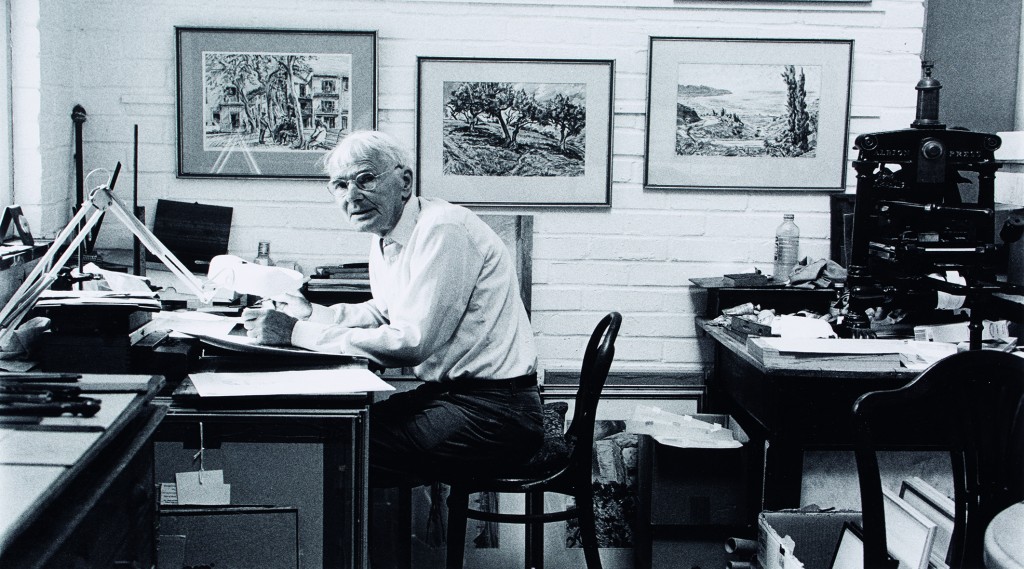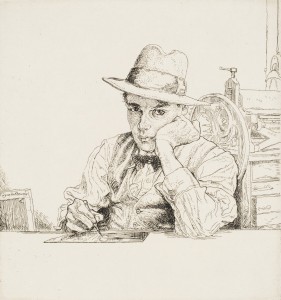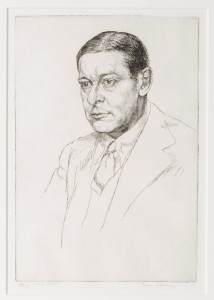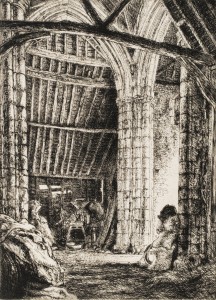
It is with some excitement that Toovey’s are offering for sale selected works from the studio of Edgar Holloway (1914-2008). The sale provides an important overview and insight into the life and work of this talented, Sussex-based artist.

Holloway was at the heart of a revival of printmaking in the 1920s and 1930s. In the various phases of his creative life he combined the Arts and Crafts ideal of the artisan artist, influenced by Eric Gill, with the pursuit of fine art. His work is represented in many of our national collections, including the British Museum, the V&A, the National Portrait Gallery, the Ashmolean Museum and the National Museum of Wales. Further afield, his work is even to be found in the Rijksmuseum, Amsterdam.

Edgar Holloway was born in Mexborough, near Doncaster, on 6th May 1914. His father, a former Yorkshire miner, sold art through his shop, including watercolours by Edgar. In January 1930 Edgar persuaded his father to buy him a small etching press and a supply of copper plates and would later write: ‘I like to say I learned to draw on copper plates.’ There is an immediacy and life to Edgar Holloway’s etchings, born of his particular gifts of observation and draughtsmanship. The influential author, journalist and art critic Malcolm Salaman reproduced a landscape print in the art magazine The Studio. By November 1930 the Twenty-one Gallery had agreed to handle his prints and would hold a series of critically acclaimed exhibitions at their Mill Street premises in Mayfair, London. His family had since moved to Essex and then Harrow, so that Edgar could be closer to the London art market.
Holloway obtained a pass to the print room at the British Museum, where he met the Keeper of Prints, Campbell Dodgson, who bought the young artist’s prints personally and for the museum’s collection. The Scottish etcher Ernest Lumsden had influenced the young Holloway and he now invited him to join the Society of Artist Printers in Edinburgh. During this period ‘Eastcote’ (Lot 36) and ‘Self-Portrait, 1932’ were among a series of successful prints.
Holloway’s gift for portraiture is expressed in his beautifully observed self-portraits. These introspective works gift us with a particular insight into the artist and the man. They chart a human procession through life with a piercing directness and integrity, which commands the viewer’s attention. These same qualities inform all of his portraits.

His family returned to Doncaster but in 1934 Edgar Holloway moved to Hampstead and studied at the Slade. The illustrator Alec Buckels introduced Holloway to T.S. Eliot, Herbert Read and Stephen Spender. There is such maturity in his portrait of ‘T.S. Eliot’ (Lot 62) that it is hard to remember that Holloway drew and etched it when he was just nineteen. Holloway would capture the portraits of many of T.S. Eliot’s circle.
Throughout his career, as well as portraiture, Holloway continued to record buildings, landscapes and the world around him. The 1936 etching of a barn interior, titled ‘Latton Priory, Essex (interior)’ (Lot 76), illustrates his command of the medium.
Ill health exempted Holloway from military service during the Second World War. In 1941 he became a Roman Catholic. In 1943, suffering with depression, he visited Capel-y-ffin, the monastery near Abergavenny, which had been home to Eric Gill in the 1920s. There he met Daisy Monica Hawkins, Gill’s last model. Within just a few weeks Edgar and Daisy were married. That she was his muse and inspiration is apparent in his sensitive studies of her, many of which are included in the sale. The couple lived at Capel and Doncaster with their growing family.
An invitation from Philip Hagreen to join the Guild of St Joseph and St Dominic at Ditchling resulted in their move to Sussex. For the next twenty years Holloway worked exclusively as a letterer, cartographer, illustrator and designer. Edgar Holloway could not foresee his return to printmaking. He sold all but eleven of his etched copper plates in the 1950s to a scrap-metal dealer. Many of the early prints included in the sale are, therefore, very rare. However, this event gifted Holloway with the opportunity to revisit and record the memory and image of earlier subjects. The artist’s depth and layers of experience allowed him to recapture the voice and spontaneity of his earlier work.
In 1972 a series of commissions for portraits and landscapes from the United States allowed him to return to his love of printmaking. Among these is ‘Self-Portrait no. 16: Prospect of America’ (Lot 51). In 1979 Daisy Monica died. In the years that followed, retrospective exhibitions were held at the Ashmolean Museum, the National Library of Wales, in London and across the country.
In 1984 Edgar Holloway married the artist Jennifer Boxall. Together they purchased Woodbarton, which was designed by Eric Gill for Desmond Chute. When the Holloway’s arrived, there was no plumbing and only an outside toilet and single cold-water tap. This artistic couple set about modernising the house to create a comfortable home and studio in which to live and work. Jennifer inspired and encouraged Edgar in these years. Edgar Holloway was the last Chairman of the Guild of St Joseph and St Dominic at Ditchling, which was dissolved in 1989.
In 1991 Holloway was elected as a Fellow of the Royal Society of Painter-Etchers and Engravers.
Alongside Holloway’s prints are a number of paintings, which demonstrate his love of watercolour as a medium from his earliest years. This remarkable collection of works by Edgar Holloway provides a rare opportunity to understand and acquire works by this gifted artist, whose prints and watercolours are rightly represented in our national collections.
By Rupert Toovey, a senior director of Toovey’s, the leading fine art auction house in West Sussex, based on the A24 at Washington. Originally published in the West Sussex Gazette.